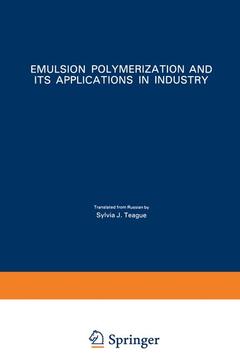Emulsion Polymerization and Its Applications in Industry, Softcover reprint of the original 1st ed. 1981
Langue : Anglais
Auteurs : Eliseeva V. I., Ivanchev S. S., Kuchanov S. I., Lebedev A. V.

There is a large body of Soviet work on emulsion polymerization, spanning a period of over three decades, that has been published primarily in the Russian language. Most of this has remained untranslated into English and hence un available to most other scientists. The value of this book lies primarily in the fact that it brings together the most important of these Soviet contributions, along with comment and analysis by the authors, who may be considered among the foremost authorities in this field in the Soviet Union. But the hundreds of literature citations go far beyond the borders of the Soviet Union and serve as an excellent bibliography of the world literature on emulsion polymerization up to the time this book was written. The book covers both fundamental and applied aspects. In the former are included discussions of particle formation mechanisms, a comprehensive theory of emulsion polymerization, copolymerization of polar monomers, and particle morphology and its implications with regard to derived film properties. Among the applied aspects are discussions of continuous emulsion polymerization, both tubular reactors and continuous stirred tank cascades, and various aspects con cerning the manufacture of some of the most important monomers, such as styrene, butadiene, vinyl acetate, methyl methacrylate, acrylonitrile, and chloroprene. This book will be an indispensable reference source for scientists who are entering the field as well as those who are experienced and who have wanted a ready access to this large body of literature.
1.- 1. Emulsion Polymerization of Nonpolar Monomers.- Classification of Emulsion Polymerization Systems.- Classification of Systems according to Monomer.- Classification of Systems according to the Emulsifier.- Classification of Systems according to Initiator.- Role of Emulsifier in Emulsion Polymerization.- Properties of Emulsifier Solutions.- Formation and Structure of Micelles.- Solubilization of Surfactant Solutions.- Influence of Emulsifier Type on Properties of Monomer Emulsions.- Role of Ionic Emulsifier.- Role of Nonionic Emulsifier.- Emulsifiers Containing Reactive Functional Groups.- Influence of Initiator on the Kinetics of Polymerization.- Water-Soluble Initiators.- Initiators Soluble in Monomer.- References.- 2. Quantitative Description of Emulsion Polymerization.- Smith-Ewart Theory.- Refinement and Extension of the Smith-Ewart Theory.- Average Molecular Weight and Molecular Weight Distribution of Polymerization Products.- Size Distribution of Latex Particles.- References.- 3. Characteristics of Emulsion Polymerization and Copolymerization of Polar Monomers.- Deviations from Kinetic Dependences Established for Styrene.- Mechanism of Particle Nucleation.- Role of Interfacial Surface Nature.- Characteristics of Emulsifier Adsorption.- Equilibrium Concentration of Monomer in Latex Particles.- Flocculation Mechanism of Particle Formation.- Kinetics of Polymerization.- Polymerization in the Absence of Emulsifier.- Role of Emulsifiers.- Colloidal Stability of Latexes from Polar Monomers.- Electrostatic Stabilization.- Steric Stabilization.- Selection of Emulsifier.- Emulsion Copolymerization of Polar Monomers.- Copolymerization with Acids and Other Ionizable Monomers.- Copolymerization with Amide Derivatives of Unsaturated Acids.- Morphology of Latex Particles and Polymer Properties Related to It.- References.- 2.- 4. Butadiene Polymers and Copolymers.- Characteristics of Butadiene as a Component of a Polymerization System.- Characteristics of the Technological Process for Preparing Rubbers and Latexes from Butadiene.- Continuous and Batch Polymerization.- Agglomeration of Particles.- Subsequent Stages in the Production of Rubbers and Latexes.- Main Types and Trade Names of Butadiene-Based Rubbers and Latexes and Their Uses.- Poly butadiene Rubbers and Latexes.- Butadiene-Styrene Rubbers and Latexes (SBR).- Nitrile Rubbers and Latexes.- Functional-Group-Containing Butadiene Rubbers and Latexes.- Other Butadiene Copolymers and Their Latexes.- References.- 5. Polymers Based on Polystyrene Latexes.- Main Types of Styrene Emulsion Polymers and Latexes and Their Applications.- Preparation of Styrene-Based Polymers and Latexes.- References.- 6. Polymers and Latexes Based on Vinyl Acetate.- Characteristics of Vinyl Acetate Polymerization.- Molecular Structure of Poly (vinyl acetate).- Types of Poly (vinyl acetate) Dispersions.- Classification according to Degree ofDispersity.- Homo- and Copolymer Dispersions.- Preparation of Dispersions Based on Vinyl Acetate.- Use of Dispersions of Poly(vinyl acetate) and Its Copolymers.- References.- 7. Latexes Based on Acrylic Monomers.- Methods of Emulsion Polymerization of Acrylic Monomers.- One-Stage and Semicontinuous Methods.- Continuous Method.- Industrial Methods of Preparing Acrylic Latexes.- Emulsifiers.- Types of Soviet Acrylic Latexes and Their Production Technology.- Use of Acrylic Latexes.- References.- 8. Chloroprene Polymers and Latexes.- Features of the Homo- and Copolymerization of Chloroprene.- Features of the Production Technology for Rubbers and Latexes from Chloroprene.- Principal Types of Rubbers and Latexes Based on Chloroprene.- Aging of Chloroprene Latexes.- References.
Date de parution : 03-2012
Ouvrage de 240 p.
15.2x22.9 cm
Disponible chez l'éditeur (délai d'approvisionnement : 15 jours).
Prix indicatif 137,14 €
Ajouter au panierThème d’Emulsion Polymerization and Its Applications in Industry :
Mots-clés :
film; industry; kinetics; mechanism; mechanisms; morphology; polymer; polymerization; production; stability
© 2024 LAVOISIER S.A.S.
